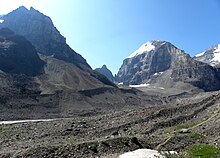moraine

Moraines ( French moraine , rubble ' ) are the entirety of the material transported by a glacier , in particular the debris deposits that are moved or piled up by glaciers as they move, as well as the formations recognizable in the terrain .
Word origin
Originally the term “moraine” was used by the people of the Chamonix area, who used it to refer to the rubble walls that the glaciers had piled up. In the scientific literature this term was introduced in 1799 by the glacier researcher Horace Bénédict de Saussure .
Types of moraines
Wandering moraines and deposited moraines

Wandering moraines are all those moraines that are still moved by the glacier. The rock material transported by the ice is called bed load . A distinction is made more precisely according to the place of education:
- Upper moraines come from the material that falls from the rock faces onto the glacier and is deposited when the glacier melts; they mainly occur in the wasteland .
- Innenmoränen include all the material is thus transported intraglazial inside the glacier.
- Sub-moraines form at the glacier base. The material of the sub moraine is sharply ground and crushed by the friction with the subsurface.
- Lateral moraines form along the edges of the glacier tongue. Their material comes from the rock on the side, but for the most part from former sub-moraines that were brought to the sides of the glacier.
- Middle moraines arise from the lateral moraines of two glaciers when they flow together ( confluence ) and unite.
Deposited moraines are moraines that have not moved after being deposited:
- Ablation moraines consist of the material of upper and inner moraines. They are left behind when the glacier's ice has melted.
- Ground moraines consist of the material of sub and inner moraines .
- Bank moraines are the deposited equivalent of lateral moraines.
-
Terminal moraines form as a pile of rubble at the end of the glacier when the glacier front does not move for a long time. You can see the greatest extent of the glacier from them.
- Set end moraines are formed by the melting of the glaciers over a longer period of time in one place, whereby larger walls are formed, which remain as an element of the landscape after the complete melting of the ice.
- Flowing moraines are a by-product of set end moraines when they change their shape by collapsing or rolling down rock material, i.e. when they "flow away".
- Upsetting moraines mark embedded clods of glacier-driven material (in a frozen state), which is pushed into the immobile moraine and built into it.
- Bed moraines arise when subsoil consisting of loose rock is included in the movement of the glacier. The upper decimetres of up to 2 m underground are sheared off and rearranged so that the lower area of the newly emerging moraine resembles the underlying rock in terms of grain size distribution and lithology , but the stratification is severely disturbed.
- Drumlins are elongated hills that run along the direction of movement of the glacier. They mostly consist of deposited moraine material, especially the ground moraine.
In recent years it has become customary in specialist literature to refer the term moraine only to the material currently in motion in the glacier ice and the relief forms that arise under and around the glacier ice. The deposits ( sediment ), on the other hand, are referred to as glacial till (or till ).
Young moraines and old moraines
After the emergence time Jungmoränen (are Weichseleiszeit , Wurm Age ) of Altmoränen (from the previous glacial distinguished).
composition
The term moraine includes all debris that was carried along and deposited by the ice. Moraines consist of material of different grain sizes , from clay to sand to larger blocks of stone . However, the material is mixed and usually has no sorting or layering according to size.
Terminal and ground moraine can also be found mixed as bed, intermediate or top layer, as well as old rock. Bank moraines , which are already deposited lateral moraines, can also have an unclean layering.
Alpinistic importance
Since moraines of loose caked consist of sand and rocks, the steep flanks are often rockfall . Most expediently, they are committed at the top of the moraine ridge. When crossing or descending from a moraine onto the glacier, you should carefully choose the most harmless place and stick to climbing tracks, if they can be seen.
Moraines can also serve as a valuable orientation aid in a structureless terrain that otherwise offers few clues.
See also
- Boulder
- Glacial series
- Glacial morphology (structure of the glaciers)
- Debris flow
- Moraine Fjord (German Moränenförde), branch of the Cumberland Bay on the north coast of South Georgia
- Pale clover (moraine clover), species of the genus clover
literature
- Albert Schreiner : Introduction to Quaternary Geology. 2nd Edition. Schweizerbart, Stuttgart 1997, ISBN 3-510-65177-4 .
Individual evidence
- ^ Zepp, Harald (2004): Geomorphology. 3. Edition. Schönigh. Paderborn, Munich, Vienna, Zurich. P. 196
- ↑ Lexicon of Geosciences: Ablationsmoräne Spektrum.de
- ↑ a b Ahnert, Frank (2003): Introduction to Geomorphology. 3. Edition. Ulm UTB. Stuttgart. P. 366
- ↑ Ehlers, Jürgen .: The Ice Age . Spektrum Akademischer Verlag, Heidelberg 2011, ISBN 978-3-8274-2327-6 .
- ^ Pepi Stückl, Georg Sojer: Mountaineering. Textbook for all types of mountaineering. 2nd updated edition. Bruckmann, Munich 1996, ISBN 3-7654-2859-0 , p. 122 ff.